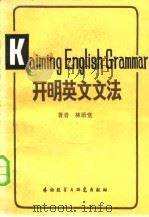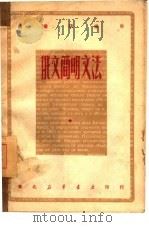《开明英文文法》
| 作者 | 林语堂著 编者 |
|---|---|
| 出版 | 北京:外语教学与研究出版社 |
| 参考页数 | 457 |
| 出版时间 | 1982(求助前请核对) 目录预览 |
| ISBN号 | 9215·120 — 求助条款 |
| PDF编号 | 86982738(仅供预览,未存储实际文件) |
| 求助格式 | 扫描PDF(若分多册发行,每次仅能受理1册) |

CONTENTS1
CHAPTER Ⅰ THE SCIENCE OF EXPRESSION1
1.10.Something to Say and Way of Saying It1
1.11.All Grammatical Forms and Constructions are Ways of Expressing Notions2
1.20.Grammar as the Science of Expression3
1.30.National Differences in Notions and Their Expressions5
1.31.National Differences in Notions5
1.40.Formal and Notional Grouping of Grammatical Facts6
1.32.English Grammar Should Teach English Ways of Think-ing and Expression6
1.41.Outline of the Course8
1.42.Living Grammar10
CHAPTER Ⅱ PARTS OF SPEECH AND CHANGE OF FUNCTION11
2.10.The Eight Parts of Speech or Word-Classes11
2.11.Definitions12
2.12.Grammatical Function14
2.13.Chinese and English Compared15
2.14.Sense of Function16
2.15.Sense of Thing17
2.16.Sense of Action and Quality18
2.17.Sense of Aspect and Manner20
2.18.Sense of Prepositional Force22
2.20.Change of Function23
2.21.Nouns Used as Adjectives24
2.22.Nouns Changed into Adjectives26
2.23.Nouns Used as Verbs27
2.30.Verbs Used as Nouns27
2.31.Verbs Changed into Nouns29
2.32.Pairs of Nouns and Verbs30
2.33.Verbs Used as Adjectives:Participles32
2.34.Spelling of Participles34
2.35 Verbs Changed into Adjectives35
2.40.Adjectives Changed into Nouns36
2.41.The Poor,the Dead,etc.37
2.42.Adjectives Changed into Adverbs:The Ending-ly38
2.43.Knowingly,Decidedly,etc40
2.50.Prepositions Used as Adjectives40
2.51.Adverbs and Prepositions Used as Nouns42
2.52.Adverbs,Prepositions and Conjunctions42
2.60.Some Interesting Compound-Words43
CHAPTER Ⅲ SENTENCE MOODS46
3.10.What is a Sentence?46
3.11.Importance of Finite Verb48
3.20.Sentence,Phrase and Clause:Subject,Predicate and Principal Verb49
3.21.Direct and Indirect Objects49
3.22.Sentence Structure:Modifiers and Conjunctions50
3.23.Phrase and Clause51
3.30.Sentence Moods52
3.31.Chinese and English Compared:Chinese Modal Particles53
3.40.Affirmation:I Do,I Am54
3.41.Can,Will,Have,Must,etc55
3.42.Affirmative Replies56
3.43.Qualified Assertion56
3.44.Emphatic Assertion57
3.45.English Reticence and Double Negatives59
3.46.Affirmation by a Retort Question60
3.50.Negation61
3.51.Aren't,Isn't,Mustn't,etc.62
3.52.No,Not a,Not Any,Nothing,etc.64
3.54.No in Negative Answers65
3.53.Few,a Few,Little,a Little65
3.55.Emphatic Negation66
3.56.“I Ain't Got Nothillg”67
3.57.Conditional Negation68
3.60.Interrogation69
3.61.Will You?Wont't You?70
3.62.The Tag-Question71
3.63.Tonal Interrogation and the Questioning Tone72
3.64.The Indirect Question and Noun Clauses73
3.71.Command,Request,Suggestion,etc.75
3.70.The Potential Moods75
3.72.Shall and Will77
3.73.Hope and Wish78
3.74.Permission,Prohibition,Obligation,etc.80
3.75.Conjecture and Possibility81
3.76.Pure Supposition:Would,Should,Could,Might83
3.77.The Subjunctive Clause85
3.80.Emotional Utterances86
3.81.Swear-Words88
4.10.Classes of Things90
CHAPTER Ⅳ PERSONS,THINGS AND THEIR GENDER90
4.20.Process and Result91
4.21.Process-Words Denoting Results92
4.30.Abstract and Contrete Nouns93
4.31.Abstract-Words with Concrete Meaning95
4.32.A Piece of Folly,a Fit of Anger,etc.96
4.40.Common and Proper Nouns97
4.41.Proper Nouns and Capital Letters98
4.51.Mass-Words99
4.50.Collectives and Mass-Words:Collectives or Group-Names99
4.60.Things,Persons and Personification:Things and Persons100
4.61.Who,Which and That101
4.62.Whose and Of Which102
4.63.Personification103
4.70.Sex and Gender105
4.71.Masculine,Feminine,Common and Neuter Genders106
4.72.Animals and Persons of Different Sex107
CHAPTER Ⅴ NUMBER AND QUANTITY109
5.10.The Notions of Number and Quantity109
5.11.Mass-Words:Grain of Sand,Bushel of Rice,etc.110
5.12.Abstract Nouns:Piece of Luck112
5.20.Singular and Plural:The Plural Endings -s and -es113
5.21.Boys,Ladies,Pianos,Potatoes115
5.22.Irregular Pluals:Fish,Dozen,Alumni116
5.23.Collectives:Government Have and Government Has118
5.24.Psychological Intent:Three Weeks Is Heaps of Time119
5.25.The Generic Singular120
5.26.Natural Plurals121
5.27.Differentiated Plurals123
5.28.Some Special Cases:Sons-in-law,the Miss Rogers,etc.124
5.30.Numerals:Numerals,Fractions and Multiples126
5.31.Indefinite Number129
5.40.Conflict of Number131
5.41.Number in Verbs133
CHAPTER Ⅵ WEIGHT,VALUE,SIZE,SHAPE AND POSITION139
6.10.National Differences in These Categories139
6.20.Expressions of Weight139
6.30.Expressions of Value140
6.40.Expressions of Size and Distance143
6.50.Expressions of Shape:English Shape-Blindness144
6.60.Expressions of Position146
6.61.Peculiar Use of Prepositions148
CHAPTER Ⅶ REPRESENTATION150
7.10.Representation150
7.20.Presonal Pronouns:Case and Person151
7.21.Mine,Thine,etc153
7.22.Influence of Modesty,Respect,Familiarity,etc154
7.23.Reflexive and Reciprocal Pronouns156
7.24.General Person:One,People,etc158
7.30.Conflict of Person and Case:Conflict of Person160
7.31.Conflict of Case:Who,Whom,Whoever,Whomever162
7.40.Thing-Pronouns165
7.41.Some,Any,None166
7.42.What167
7.43.One,Thing,Affair,Something,etc167
7.44.That169
7.45.It170
7.50.Metaphors:Metaphors and Figurative Expressions173
7.60.Indirect Statements:Direct and Indirect Statements177
7.61.Tense of Dependent Clauses179
7.70.Representation by Omission181
CHAPTER Ⅷ DETERMINATION186
8.10.Representation,Determination and Modification186
8.11.Classes of Pronouns187
8.20.Distinction:This,That,Same,Other188
8.30.Possessive Pronouns and Nouns190
8.40.Apposition:Apposition and Example192
8.50.Sequence:the Ordinals194
8.60.Alternation and Distribution:Either,Each,etc195
8.70.Definite and Indefinite:A,An and The197
8.71.Generalization:A Cat,The Cat,Cats199
8.72.Special Uses of A and The201
8.73.Omission of A and The203
8.80.Indetermination:Whatever,Whoever,etc207
CHAPTER Ⅸ MODIFICATION210
9.10.Modification:Its Importance210
9.11.Word-Classes and Word-Ranks212
9.20.Relationship between Modified and Modifier214
9.21.The Use and Omission of Hyphens217
9.22.Relationship between Modifiers220
9.23.Co-ordinate Modifiers220
9.24.Subordinate Modifiers223
9.25.Shifted Ranks226
9.26.Transformed Phrases as Modifiers230
9.27.Nouns and Verbs as Modifiers232
9.30.Phrase and Clause Modifiers235
9.31.The Infinitve Phrase as Modifier235
9.32.The Split Infinitive,etc.239
9.33.Need to,Dare to241
9.40.The Participial Phrase as Modifier243
9.41.Misconnected Participles246
9.42.The Absolute Participial Phrase247
9.50.The Prepositional Phrase249
9.51.Prepositions for Brevity250
9.52.Prepositions at End251
9.53.But,Than252
9.54.Some Special Uses of English Prepositons253
9.60.The Relative Clause255
9.61.That as a Defining Relative Pronoun256
9.62.Which as a Commentative Relative Pronoun257
9.63.Which Modifying Statements259
9.64.In Which,from Whom,etc259
9.65.Which...It,Which...Them,etc261
9.66.That...to,That...for,etc261
9.67.That Used for in Which,for Which,etc262
9.68.That Dropped262
9.691.As as a Relative Pronoun263
9.70.Relative Adverbs When,Where and Why264
9.692.But as a Relative Pronoun264
9.71.When Called,When Resting266
9.80.Phrase and Clause Modifiers Summarized267
9.81.Post-Nominal Position of Modifiers268
9.82.Economy in Phrase and Clause Modifiers269
9.83.The Nominal Phrase270
9.84.Joining of Phrases270
9.90.The Predicate Complements271
9.91.“I Made Him Go”273
13.60.Auxiliaries:Might,Could,Would,Should and Ought274
10.10.Degrees of Comparison:Their Relative Nature275
CHAPTER Ⅹ COMPARISON AND DEGREE275
10.11.The“Three Degrees of Comparison”276
10.12.More Better,Next Best,etc278
10.13.Superiority,Equality and Inferiority279
10.14.Implied Comparison280
10.15.Words That Cannot Be Compared281
10.16.Weakened Superlatives282
10.20.Comparison with a Standard284
10.30.Degree of Difference288
10.31.Indeterminate Degrees288
10.32.Limitation294
10.33.Cumulative Degrees296
10.40.Choice and Comparison297
10.50.Comparison and Case299
CHAPTER Ⅺ ASPECTS OF ACTION302
11.01.The Study of the Verb302
11.02.What is an Aspect?303
11.03.The English Verbal Aspects305
11.10.Action and Condition305
11.11.Being and Doing308
11.20.Transitive and Intransitive Verbs309
11.21.Intransitive Verbs and Prepositions311
11.22.Intransitive Verbs Used Transitively315
11.30.Active and Passive:The Term“Voice”317
11.31.Formation of the Passive317
11.32.Use of the Passive319
11.33.Active and Passive Nouns320
11.34.Active and Passive Adjectives321
11.35.False Active322
11.40.Complete and Incomplete Action323
11.41.Present Perfect and Adverbs of Time324
11.42.Use of the Perfect325
11.43.Incompletion:Use of the Progressive330
11.44.Participles and the Conclusive Aspect331
11.50.Beginning,Continuation and End332
11.60.Durative and Punctual:Point of Time and Period of Time334
11.61.Punctual and Durative Verbs335
11.62.Duration in Prepositions336
11.70.Habitual Action337
11.80.Tentative Action339
11.90.Miscellaneous Minor Aspects:Causative,Reiterative,Reflexive and Reciprocal340
CHAPTER Ⅻ SUBJECT AND OBJECT(TRANSITIVE ACTION)342
12.10.Subject and Doer342
12.11.Object and Party Affected343
12.12.Grammatical Subjects and Objects344
12.20.Kinds of Subject345
12.21.It as Subject345
12.22.There Is347
12.30.Transitive Action and Objects:Transitive Action348
12.31.Direct and Indirect Objects349
12.40.Passive Subjects:Passive Verbs with Objects350
12.41.Passive Intransitive Verbs351
12.50.Impersonal Subjects352
13.10.The Time Schene:Present,Past and Future355
CHAPTER ⅩⅢ TIME OF ACTION355
13.20.Present:What is Present?356
13.21.Habitual Action and Eternal Truths357
13.30.Future:Expression of Future358
13.31.Shall and Will358
13.32.Chinese“Chiang”and“Yao”360
13.33.May and Is to361
13.34.Present Used for Future362
13.41.Use of the Past363
13.40.Past:Past Actions are Facts363
13.42.Past Visualized:“Dramatic Present”365
13.43.Tense in Dependent Clauses366
13.50.Irregular Verbs366
13.61.Expression of the Past with Auxiliaries377
13.62.Declinable Substitutes for the Auxiliaries378
13.70.Conjunctions Expressing Time380
13.80.Adverbs of Time382
13.90.Time in Nouns383
14.11.Fact and Fancy385
CHAPTER ⅩⅣ FACT AND FANCY385
14.10.The Verbal Moods:Close Relation to Sentence Moods385
14.12.Subjective and Objective Moods386
14.20.The Subjunctive Mood:Shifting of Tense386
14.21.General Supposition:If He Should Have,If He Have388
14.22.Different Degrees of Supposition390
14.23.If I Was,If I Were392
14.30.The Potential Moods392
15.10.Conjunctions and Logical Relationships396
15.20.Simple,Compound and Complex Sentences396
CHAPTER ⅩⅤ RELATIONSHIPS396
15.30.Co-ordinate and Subordinate Clauses399
15.40.Logical Relationships401
15.41.Combination401
15.42.Opposition402
15.43.Selection and Substitution403
15.44.Exclusion and Inclusion404
15.45.Condition and Concession405
15.46.Cause and Effect406
15.47.Motive and Purpose407
15.48.Comparison and Conformity408
15.49.Time and Logical Relationships410
15.50.Interrogative Adverbs and Pronouns412
15.60.Punctuation:Logical and Phonetic Basis412
15.61.The Comma413
15.62.The Semi-Colon415
15.63.The Colon416
15.65.The Exclamation and Question Marks417
15.66.Inverted Commas417
15.64.The FullStop417
15.67.The Dash and the Dotted Line418
15.68.Parentheses and Brackets420
15.70.Loose and Periodic Sentences:Loose and Periodic Sen-tence Structure421
CHAPTER ⅩⅥ ECONOMY OF EXPRESSION423
16.10.Ease and Economy423
16.20.Shifting of Function423
16.21.Change of Clauses into Phrases424
16.30.Ellipsis:Dropping of Auxiliary Words426
16.31.Dropping of Principal Words426
16.22.Change of Phrase Modfifiers into Word-Modifiers426
16.32.Ellipsis in Dependent Clauses427
16.33.And that428
16.40.Abbreviations and Contractions:Contractions428
16.41.Abbreviations429
16.42.Monosyllabism430
16.50.Mottoes432
16.60.Economy and Emotional Language432
16.70.Economy and Business432
SYNOPSIS OF FORMAL GRAMMAR434
INDEX OF SUBJECTS AND TERMS444
1982《开明英文文法》由于是年代较久的资料都绝版了,几乎不可能购买到实物。如果大家为了学习确实需要,可向博主求助其电子版PDF文件(由林语堂著 1982 北京:外语教学与研究出版社 出版的版本) 。对合法合规的求助,我会当即受理并将下载地址发送给你。
高度相关资料
-

- 开明英文讲义 第3册
- 1976 台湾开明书店
-

- 英文法
- 1973.08 白水社
-

- 開明英文文法
- 1960.01 文建書房
-

- 俄文简明文法
- 1949 东北新华书店
-

- 开明文选 12
- 开明书店
-

- 详明汉释英文法
- 袁氏出版社
-

- 开明文学辞典
- 1932 开明书店
-

- 社会主义精神文明学概论
- 1988 长沙:湖南人民出版社
-

- 开明英文文法
- 1982 北京:外语教学与研究出版社
-

- 简明现代英文法 上
- 1990 三民书局股份有限公司
-

- 简明现代英文法 下
- 1990 三民书局股份有限公司
-

- 英文法
- 1967 世界书局
提示:百度云已更名为百度网盘(百度盘),天翼云盘、微盘下载地址……暂未提供。➥ PDF文字可复制化或转WORD


